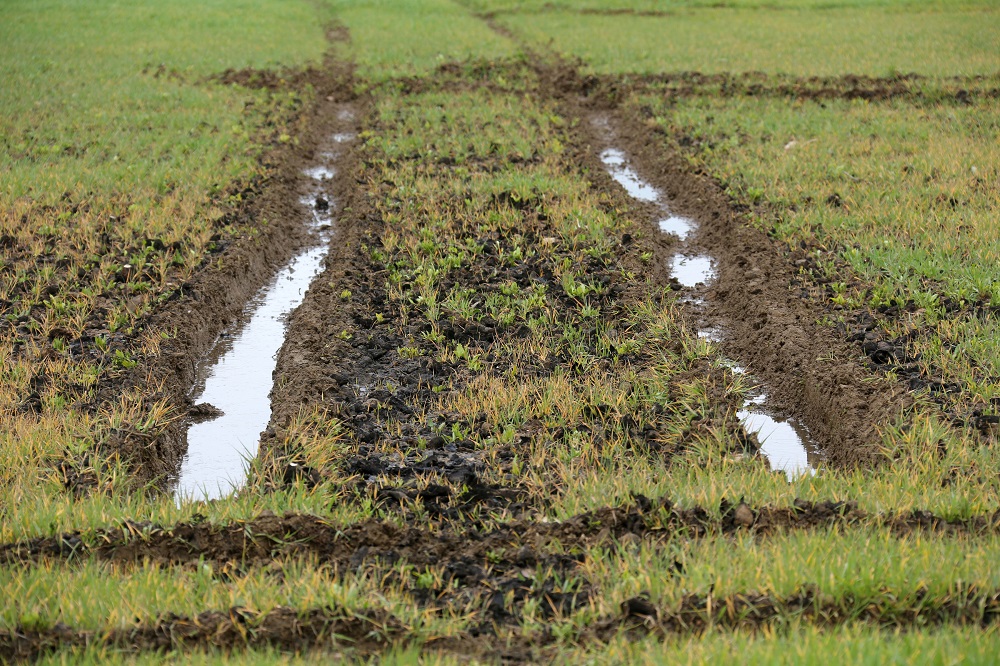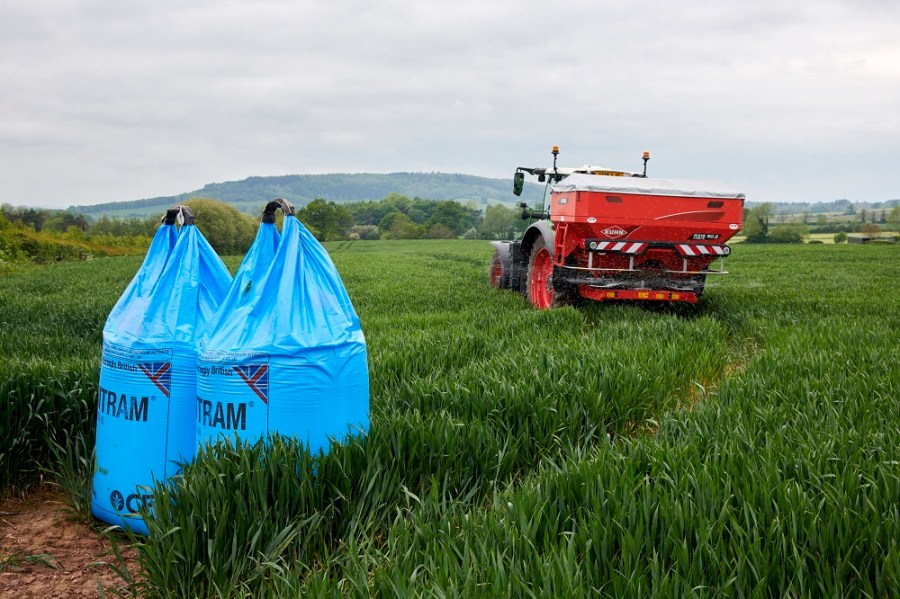An extraordinary autumn and winter will likely call for some unusual tactics this spring. CPM looks at how early spring nitrogen and weeds can be managed to get the best out of crops in the ground.
There are so many variables to take into account this year.
By Rob Jones, Lucy de la Pasture and Charlotte Cunningham
Understanding the effects of the wet autumn and relatively mild winter to date and estimating fertiliser requirements for 2020 will be extremely challenging, believes soil N testing specialist Dr Mechteld Blake-Kalff of Hill Court Farm Research in Gloucestershire.

Slow-growing crops, with poorly developed root systems may be less able to take up nutrients.
Whilst the overriding picture is one of significant rainfall and potentially high levels of N loss from soils, this could be an oversimplification with highly variable conditions across the country complicating matters, she says.
“It’s very difficult to paint an overall picture. It’s been very wet, but some areas have been affected much more than others. Poor weather in itself doesn’t necessarily have as bad an effect on N levels as people think, particularly on heavier soils, but lighter ones can be a problem.
“It’s likely the topsoil will be lower in nitrogen because it will have leached downwards, but our experience is that the crop is able to pick some of this up later in the season when it starts growing properly,” she says.
“We’ve had quite dry conditions for the 18 months before the wet conditions started and there was actually a lot of nitrogen available in the system. This could have leached down, but it could still be there at depth within the soil profile.”
With many fields at or above field capacity and not effectively draining, denitrification as a loss pathway could also be a problem, she points out.
“Many fields have standing water which creates anaerobic conditions in soil and this, combined with relatively warm soil conditions, will drive the loss of nitrogen as N2O (nitrous oxide). Further nitrogen could equally be being lost to the environment through leaching,” says Mechteld.
As well as loss to the air and through leaching, it’s also possible that nitrogen has shifted sideways, especially in fields with a sloping aspect. “Some N could have collected at the bottom of fields, so in the valleys of sloping fields, crops could be at risk of lodging.”
The two things that drive mineralisation of nitrogen in the soil are temperature and how wet it is, she points out.
“Temperature affects the rate of nitrogen being mineralised, but you do need moisture to get it into the crop once this has taken place. So where you have a very hot spring and no rainfall – like last year – nitrogen is mineralised, but it’s not actually taken up by plants.
“The 2017 and 2018 autumns were very warm and we saw mineralisation all the way up to Christmas and because it didn’t rain there was a lot of nitrogen around. In contrast, this last autumn was colder, so it’s likely less mineralisation has taken place, but it’s also possible that what was mineralised has leached down by now.”
The only way a grower is going to understand what the situation is on the farm is to carry out detailed soil testing, she believes.
To get the full story, it’s not just about Soil Mineral Nitrogen (SMN) at the time of testing, advises Mechteld. “Also estimate how much nitrogen has already been taken up by plants, and how much is likely to become available through mineralisation as the season progresses. The aim is to get a picture of total Soil Nitrogen Supply (SNS) and this is really where a CF N-Min test is invaluable, particularly in difficult years like this one.
“Consider doing a few tests to build an overall soil nitrogen picture, taking representative samples from light and heavy soils and those where FYM and organic nutrient sources have been applied,” she suggests.
CF arable agronomist Allison Grundy believes it will be virtually impossible to make accurate fertiliser recommendations without such testing this year and urges all growers to be extremely careful with fertiliser applications on backward crops.
“There are so many variables to take into account this year. 2019’s high yields would have inevitably resulted in high nutrient offtakes and this was followed up by many growers not being able to apply their usual quantities of FYM because of the poor weather.
“You’ve then got the complication of slow-growing crops, with poorly developed root systems less able to take up nutrients and big question marks over just how much nitrogen is left in the soil after all the rain. Then for wheat drilled during Jan and Feb, these crops are likely to have very specific fertiliser requirements.”
The starting point is undoubtedly to establish total Soil Nitrogen Supply (SNS), but from there focus on nitrogen source, timing and frequency of applications, she suggests.
“Get your nitrogen on as early as practically possible, but applications have to be managed so as not to overwhelm small crops with too much nitrogen at any one time, otherwise its recovery is likely to be compromised.
“Root systems are likely to be poorly developed, so getting the most from early applications will require moving to more frequent, smaller applications of nitrogen than in a typical spring. But these applications must also be in good ground and weather conditions to avoid losing nitrogen to the wider environment.
“To give the crop the best chance of recovering nitrogen from earlier applications, quantities should at least be split in two or possibly three if traditionally you would apply a total of 60kgN/ha at the first application timing to winter wheat,” says Allison.
Evidence is emerging from trials that to make full use of the nitrogen applied to the crop, four or five applications over the season can be beneficial when compared with the more traditional three-way split, she explains.
“Applying more frequently means the crop will receive smaller amounts each time improving the recovery of nitrogen by the crop and this will also help build tiller numbers,” she adds.
Herbicide rethink on the cards?
The wet autumn means that weed control plans may need a rethink. In recent seasons, grassweed control has relied on a robust residual herbicide stack applied in autumn, but the sodden conditions mean that many wheat crops haven’t received a pre-emergence herbicide, leaving all to do in the spring.
“In the crops that got drilled, weeds are likely to be a problem this spring,” says Bayer’s Darren Adkins. “Poor establishment and waterlogged ground can both leave an opportunity for weeds to prosper, so weed control this spring will be vital,” he says.
The first step is to assess the crop conditions and level of weed infestation, particularly from blackgrass and ryegrass, before deciding on next steps. The difficulty will be finding a balance between the short-term aim of getting a decent crop and the longer-term need to get the rotation back on track and soil back in good order.
“A smaller area of wheat and an increase in spring crops, particularly spring barley, has changed the usual spring decision-making process. In a normal spring, the patchy wheat crops would be candidates to be re-drilled but, in all likelihood, farmers will be looking to nurse any salvageable crops through to harvest this season. Looking further ahead, rotation and soil have both been badly affected, so this coming autumn will be important to get things back on track.”
Thinking about options for next autumn may also make decision-making this spring clearer, he believes. “With a lower wheat area, there’s obviously a big incentive to go for yield, even in crops with significant weed populations that will have high seed return. But this is only viable if there’s an option of a cleaning crop on bad fields next autumn. Going straight into another winter cereal or oilseed rape would risk a long-term build-up of grassweeds.
“There may be some upside for farms which are planting more spring crops to compensate for wheat not getting drilled. There should be some flexibility planning the rotation in the autumn because of the large area after spring cropping, which should have had decent weed control. Consequently, any winter wheat can be pushed for yield this season without worrying as much about weed seed return,” believes Darren.
This spring, winter wheat will probably need a post-emergence herbicide to counteract the lack of a pre-em and combat any broadleaf weeds that germinate in autumn.
“Pacifica Plus (mesosulfuron+ iodosulfuron+ amidosulfuron) is new to the market this spring, it has the same grassweed performance as Pacifica, coupled with broadleaf weed control from the addition of amidosulfuron. This brings activity against many competitive weeds, including cleavers, common chickweed, mayweeds and charlock,” he says.
On farm, the aim will probably be to get weed control done as soon as possible to free up time for fungicides and spring drilling, but it’s important to have some patience, he says. “Conditions have a big effect on the efficacy of post-ems. You don’t want to go too early and get poorer control because it will be the only chance to reduce grassweed populations.”
The main requirement for good control from Pacific Plus is active growth and a dry, calm day so the herbicide can settle on the target leaf, he highlights. “As well as contact herbicides, residual herbicides such as 0.3 l/ha Liberator (flufenacet+ diflufenican) can be applied until 31 March or GS23. Residual protection will help control any spring-germinating weeds, but it’s not likely to have much of an effect against large established weeds because they will have roots below the zone of activity in the soil.”
Spring-drilled crops face higher grassweed burden
Blackgrass emergence is likely to be impacted by the conditions this winter, with autumn germination being delayed by induced dormancy in wet soil. That means an increased chance some will germinate in spring when the soil dries out, believes Barrie Hunt, technical manager at Gowan.
“Typically we see 15-20% of blackgrass populations germinating in spring. This spring levels are likely to be well above this, so think about planning ahead and which chemistry is going to be most effective.”
According to Barrie, the main barrier to achieving robust control is a lack of available and effective chemical options. “The vast majority of pre-emergence herbicides have greatly reduced spring application rates, with individual flufenacet products being limited to rates delivering just 120g/ha of active ingredient — that’s 50% of the autumn blackgrass rate.”
So what’s the solution? Alongside some of the pendimethalin-containing products, Barrie believes both Avadex Factor and Avadex Excel 15G (liquid and granular formulations of tri-allate) could help give growers the edge over blackgrass this spring.
“Both Avadex products deliver a full effective grassweed dose at all cereal drilling dates — autumn or spring,” he explains.
In terms of crop suitability, Avadex Excel 15G can be used on both spring barley and spring wheat, while Avadex Factor is suited solely to spring barley, says Barrie. “In spring barley both can be used either pre-drilling or post-drilling pre-emergence. This really widens the application window, allowing more time to get it on, without affecting performance.”
Though Avadex isn’t claimed to be a silver bullet, it could be a useful part of the solution — particularly this season — adds Barrie. “There’s no doubt it’s going to be a challenging year. But with proper planning, and by optimising the most effective products, growers should hopefully be able to put themselves in a much stronger position heading into harvest 2020.”




